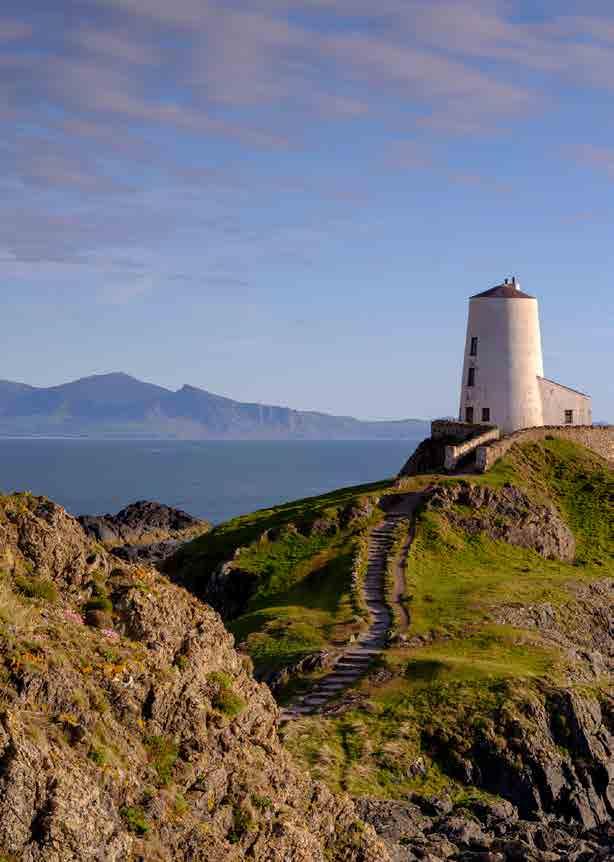
3 minute read
Pier to Pier
In the first of a two-part series, Dene Bebbington uncovers the fascinating history of two of the oldest piers in North Wales…
Do you remember childhood visits to the seaside where you could enjoy simple pleasures like making sandcastles on the beach and paddling in the sea? If you went to the right town then you could also safely have fun above the waves on a pleasure pier, one of the great inventions of our Victorian ancestors.
Coastal towns were often served by jetties at which boats could dock before the advent of railways in 1830 which led to more affordable overland travel. Initially it was the well off who were able to travel and stay at the seaside. They were attracted by the idea of sea air being beneficial for health, and by walking on a jetty they could breathe the freshest of air while doing a spot of people watching.
Their new tradition of promenading on jetties didn’t go unnoticed by astute businessmen. They realised an opportunity to make money from pleasure piers offering more than just a landing stage for paddle-steamers and a deck for people to walk over the waves. Thanks to them, Britain’s first pleasure pier opened over two centuries ago at Ryde on the Isle of Wight in 1814.
Wales got its first pier at Beaumaris, Anglesey, in 1846. This short structure of just 300ft later suffered storm damage and had to be rebuilt in 1872. Then in 1895 it was extended, a pavilion opened at the pier head and a railway baggage line added. It is unusual in design, having the shoreward section made from stone with only a stubby skeletal structure that’s supported by piles driven into the seabed. Pleasure steamers were a common sight at the pier in the years before the Second World War, especially in the summer months.
As many pier owners discovered to their cost, the sea is a harsh and unforgiving place to build on. Unfortunately, the cost of maintenance and repairs was a burden that not all pier owners could keep up with. Steamer traffic dwindled at Beaumaris Pier, leaving it in poor condition and likely to be demolished by the 1960s. Only a donation from a local yachtswoman saved it. Ownership passed to the town council who, using this donation, repaired the pier.
Nowadays a walk on the pier remains worthwhile for the fantastic view over to Eryri which can be enjoyed from seating at the pier head, or inside the shelter in poor weather. The steamers are long gone but you can take to the water on a boat trip from the landing stage over to Puffin Island. Those without good sea legs can instead take part in activities such as crabbing and fishing.
While Beaumaris Pier always had few amenities, Wales’ second pier at Llandudno – which opened in 1877 – has more to offer visitors and is the country’s longest spanning nearly half a mile. It’s unique in being “Y” shaped at the landward end giving it two entrances. Even though it wasn’t fully completed when opened, people were keen to experience this new pier. A newspaper report of the time states that “a throng of visitors flocked upon it, and it presented quite a lively appearance.” For many years an admission fee was charged which included music played at the pier head bandstand – a common feature of piers in the 19th Century.
It’s not surprising that storms are a perennial danger to spindly looking piers. Only a year after opening one inflicted light damage on Llandudno’s landing stage. Other risks for piers are corrosion of the iron piles, collisions from ships and fires. Also, some piers were sectioned in the Second World War so they couldn’t be used by the Germans in an invasion.
Llandudno Pier escaped that fate and was used for Home Guard training.
An ornamental pavilion at the pier head was added in 1905. Still standing, it’s flanked by two smaller buildings, and along the length of the pier are patterned railings and several kiosks. The colour scheme is an appealing nautical two-tone of blue and white. As ever, the best thing about the pier is the chance to stroll safely over the sea to take in the superb views of Llandudno seafront and the Great Orme. Kids wanting more stimulation have plenty of fun playing the colourful arcade amusements, some of them using technology that the first pier goers couldn’t have imagined.
Beaumaris Pier isn’t the prettiest, and its utilitarian appearance means that it’s unlikely to garner any design accolades, unlike Llandudno’s which won the Pier of the Year in 2005 – an award which cemented the everlasting appeal of this iconic pier and its importance to the town. n








